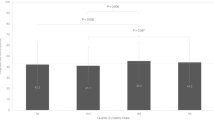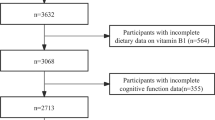Abstract
Objectives
We aimed to investigate the association of nut intake with cognitive function in Chinese adults aged 55 and over.
Design
This was a prospective open cohort study with repeated measurements of diet and cognition scores.
Participants/settings
4822 adults aged 55 and over participating in the China Health Nutrition Survey during 1991–2006.
Measurements
Global cognitive function measured repeatedly in 1997, 2001, 2004, and 2006 using a subset of modified Telephone Interview for Cognitive Status; poor cognitive function was defined as cognition score<7. Nut consumption was collected using 3-day 24 recall method in 1991, 1993, and at surveys of cognition assessment.
Statistical analyses performed
Multilevel mixed effect linear regression and logistic regression analysis were conducted to assess the association with cognitive function.
Results
The unadjusted cognitive score decreased by 0.29 (95% CI 0.22–0.28) with one-year aging during 1997–2006. Nut intake of more than 10g/d was associated with higher cognition score by 0.63 points (95% CI 0.15–1.12) or 40% less likely to have poor cognitive function (OR 0.60, 95% CI 0.43–0.84) after adjusted for demographic, lifestyle behavioural, BMI, and energy intake.
Conclusions
Nut consumption was inversely associated with cognition decline.
Similar content being viewed by others
References
Smith JP, Strauss J, Zhao Y. Healthy aging in China. J Econ Ageing. 2014;4(12):37–43. doi: https://doi.org/10.1016/j.jeoa.2014.08.006.
Wu YT, Ali GC, Guerchet M et al. Prevalence of dementia in mainland China, Hong Kong and Taiwan: an updated systematic review and meta-analysis. Int J Epidemiol. 2018;doi: https://doi.org/10.1093/ije/dyy007.
Steele M, Stuchbury G, Münch G. The molecular basis of the prevention of Alzheimer’s disease through healthy nutrition. Exp Gerontol. 2007;42(1–2):28–36.
Kuo HK, Yen CJ, Chang CH, Kuo CK, Chen JH, Sorond F. Relation of C-reactive protein to stroke, cognitive disorders, and depression in the general population: systematic review and meta-analysis. Lancet Neurol. 2005;4(6):371–380.
Gorelick PB, Scuteri A, Black SE, et al on behalf of the American Heart Association Stroke Council, Council on Epidemiology and Prevention, Council on Cardiovascular Nursing, Council on Cardiovascular Radiology and Intervention, Council on Cardiovascular Surgery and Anaesthesia. Vascular contributions to cognitive impairment and dementia: A statement for healthcare professionals from the American Heart Association/American Stroke Association. Stroke. 2011;42(9): 2672–2713. doi:https://doi.org/10.1161/STR.0b013e3182299496.
Bourre JM. Effects of nutrients (in food) on the structure and function of the nervous system: update on dietary requirements for brain. Part 1: micronutrients. J Nutr Health Aging. 2006;10:377–385.
Neale EP, Tapsell LC, Guan V, Batterham M. The effect of nut consumption on markers of inflammation and endothelial function: a systematic review and metaanalysis of randomized controlled trials. BMJ Open. 2017;7: e016863.doi:https://doi.org/10.1136/bmjopen-2017-016863.
Barbour JA, Howe PR, Buckley JD, Bryan J, Coates AM. Nut consumption for vascular health and cognitive function. Nutr Res Rev. 2014;27(1):131–58. doi: https://doi.org/10.1017/S0954422414000079.
O’Brien J, Okereke O, Devore E, Rosner B, Breteler M, Grodstein F. Long-term intake of nuts in relation to cognitive function in older women. J Nutr Health Aging. 2014;18 (5):496–502.
Nooyens A, Bueno-de-Mesquita H, van Boxtel M et al. Fruit and vegetable intake and cognitive decline in middle-aged men and women: the Doetinchem Cohort Study. Br J Nutr. 2011;106:752–761.
Li M, Shi Z. Dietary Pattern during 1991–2011 and its association with cardio metabolic risks in Chinese adults: The China Health and Nutrition Survey. Nutrients. 2017;9(11). doi: https://doi.org/10.3390/nu9111218.
Zhai FY, Du SF, Wang ZH, Zhang JG, Du WW, Popkin BM. Dynamics of the Chinese diet and the role of urbanicity, 1991–2011. Obes Rev. 2014;15(S1):16–26.
Popkin BM, Du S, Zhai F, Zhang B. Cohort Profile: The China Health and Nutrition Survey—monitoring and understanding socio-economic and health change in China, 1989–2011. Int J Epidemiol. 2010;39(6):1435–40.
Plassman BL, Welsh KA, Helms M, Brandt J, Page WF, Breitner JC. Intelligence and education as predictors of cognitive state in late life: a 50-year follow-up. Neurology. 1995;45(8):1446–50.
Lei X, Hu Y, McArdle JJ, Smith JP, Zhao Y. Gender Differences in Cognition among Older Adults in China. J Hum Resour. 2012;47(4):951–71.
Shi Z, Li M, Wang Y, Liu J, El-Obeid T. High iron intake is associated with poor cognition among Chinese old adults, and varied by weight status—A 15-year longitudinal study among 4852 adults. doi: https://doi.org/10.1093/ajcn/nqy254.
Yang Y. Chinese Food Composition Table 2004. Beijing: Peking University Medical Press, 2005.
Yao M, McCrory MA, Ma G et al. Relative influence of diet and physical activity on body composition in urban Chinese adults. Am J Clin Nutr. 2003;77(6):1409–16.
Hu FB, Stampfer MJ, Rimm E et al. Dietary fat and coronary heart disease: a comparison of approaches for adjusting for total energy intake and modelling repeated dietary measurements. Am J Epidemiol. 1999;149(6):531–40.
Singer JD, Willettt JB. Applied longitudinal data analysis: modelling change and event occurrence. Oxford: Oxford University Press, 2003.
National Bureau of Statistics of China. BRICS Joint Statistical Publication. 2017. Beijing. National Bureau of Statistics Publication House. August 2017. ISBN 978-7-5037-8240-4 P147.
International Nut & Dried Fruit. Nuts and dried fruits. Statistical yearbook 2017/2018. https://doi.org/www.nutfruit.org/who-we-are/news-and.../inc-2017-2018-statistical-yearbook (accessed on 18th May 2018).
Tsujita T, Shintani T, Sato H. Preparation and characterisation of peanut seed skin polyphenols. Food Chem. 2014;151:15–20.
Casas R, Sacanella E, Estruch R. The immune protective effect of the Mediterranean diet against chronic low-grade inflammatory diseases. Endocr Metab Immune Disord Drug Targets. 2014;14(4):245–54.
Jimenez Pereperez J, NMartin C, Lopez-Miranda J et al. a Mediterranean diet, high in monounsaturated-fat and a low fat diet improve endothelial function in hypercholesterolemic patients. Atherosclerosis. 2000;151:215–215.
Miller MG, Thangthaeng N, Poulose SM, Shukitt-Hale B. Role of fruits, nuts, and vegetables in maintaining cognitive health. Experimental Gerontology. Exp Gerontol. 2017;94:24–28. doi: https://doi.org/10.1016/j.exger.2016.12.014.
Xiao Y, Huang W, Peng C et al. Effect of nut consumption on vascular endothelial function: A systematic review and meta-analysis of randomized controlled trials. Clin Nutr. 2018;37:831–839. doi: https://doi.org/10.1016/j.clnu.2017.04.011
Berk L, Lohman E, Bains G et al. Nuts and Brain Health: Nuts Increase EEG Power Spectral Density (µV&[sup2]) for Delta Frequency (1–3Hz) and Gamma Frequency (31–40 Hz) Associated with Deep Meditation, Empathy, Healing, as well as Neural Synchronization, Enhanced Cognitive Processing, Recall, and Memory All Beneficial For Brain Health. FASEB J. 2017;31(s1): 624–636.
Barbour JA, Howe PR, Buckley JD, Bryan J, Coates AM. Cerebrovascular and cognitive benefits of high-oleic peanut consumption in healthy overweight middle-aged adults. Nutr Neurosci. 2017;20: 555–562. Doi: 10.1080/1028415X.2016.1204744.
USDA Foreign Agricultural Service; US Department of Agriculture. Tree Nuts: World Markets and Trade. 2017. https://doi.org/www.statista.com/statistics/675987/walnut-production-share-worldwide-by-country/(accessed on 18th May 2018).
Author information
Authors and Affiliations
Corresponding author
Electronic supplementary material
Rights and permissions
About this article
Cite this article
Li, M., Shi, Z. A Prospective Association of Nut Consumption with Cognitive Function in Chinese Adults Aged 55+ _ China Health and Nutrition Survey. J Nutr Health Aging 23, 211–216 (2019). https://doi.org/10.1007/s12603-018-1122-5
Received:
Accepted:
Published:
Issue Date:
DOI: https://doi.org/10.1007/s12603-018-1122-5




